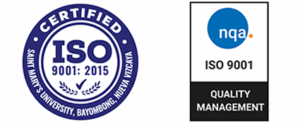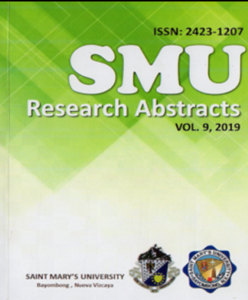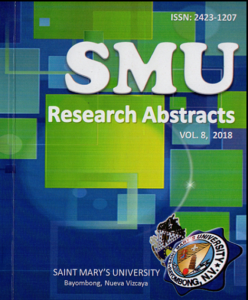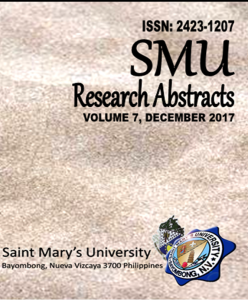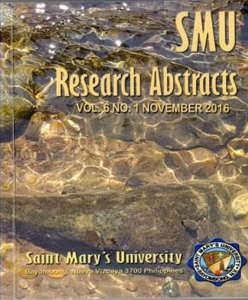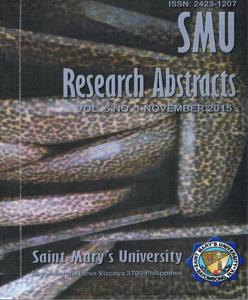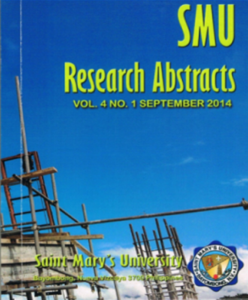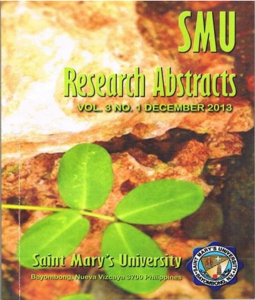Research Center
VISION
We envision the SMU-Research Center as:
A service-oriented center for the continuing advancement of knowledge, development of scientific attitude, and the conservation, transmission and promotion of national heritage.
General Objectives
To realize its vision-mission, SMU-Research Center aims to:
- promote the advancement of knowledge, and development of a scientific attitude among faculty, and students of the University, and among the intellectual leaders of the region;
- conserve, transmit and promote the national cultural heritage, and satisfy the need for relevant researches as imperative to national and regional development, especially in relation to the Cagayan Valley Region and Cordillera Administrative Region (CAR); and,
- coordinate and assist on-going research activities of the University, plan for new researches and set agenda for research avenues and disseminate findings of completed studies for their proper consumption.
Specific Objectives/Functions
The SMU-Research Center specifically commits itself:
- to serve as a clearing-house for all institutional researches of the University;
- to initiate the conduct of research activities within the framework of the University Research Agenda and the CHED-NHERA;
- to provide technical support and staff undertaking researches and to recommend financial support for deserving researchers;
- to coordinate all research publications of the University.
History of the University Research Center
The present Saint Mary’s Research Center had its beginning in 1970 when Rev. John van Bauwel, CICM, President of Saint Mary’s College, created a committee to put up a College research journal under the auspices of a Research Department. The maiden issue of the college research journal, the Journal of Northern Luzon, came out in July 1970.2 In 1971-72, Dr. Demetrio N. Espino was appointed Chairman of the Research Department and Editor of the Journal of Northern Luzon. Dr. Crisanta R. Espino took over as Journal of Northern Luzon Editorial Board Chairman in 1971-1972 when D. Espino was on study leave at CEU. In 1973-1980, Dr. Espino resumed as Head of the Research Department and editor of the Journal of Northern Luzon (1973-1980). The Associate Editors were Dr. Virgilio Aguilar Sr. (1970-74); Norma R. dela Cruz (1970-74); Bonifacio V. Ramos (1973-1983); and Corazon G. Soberano (1970-85). The intent of the Journal of Northern Luzon was to publish researches about (a) the culture, history, and geography of Northern Luzon, and (b) the researches of graduate faculty and students (hence it also served as the research journal of the Graduate School).
In 1980, the College President established a Research and Science Information Center (RSIC) and designated Mr. Bonifacio V. Ramos, concurrent Academic Librarian, as Head. The RSIC, which was linked to the Library and Graduate School in 1980–1990 functioned as the Research Department. Since its inception, the Research Department has been connected with the Graduate School. From 1985-1990, it served as a dissemination center of theses, dissertations, and abstract bibliography and researches of the Graduate School.
In 1990, Fr. John van Bauwel revitalized the Research Department then alternately called Research Center by creating a committee 3 to formulate its vision-mission, objectives, structure, and programs. Meanwhile, he also created an initial research fund for the Center under the SMC Scholarship and Development Foundation.
In 1992, the President created an Ad-Hoc Committee to review the Research Department’s objectives, functions, programs and projects. By the same year it was officially
1 The Editorial Board was composed of Juana V. Aluning, Demetrio N. Espino (Chairman), Robert M. Picart as Editors; the Associate Editors were Virgilio B. Aguilar, Jovena S. Aquino, Norma R. dela Cruz, Fausto A. Estrada, Ofelia L. Fontanilla, Felicidad G. Garingan, Arlyne L. Genato, Stephanie D. Quiban, Corazon G. Soberano, Marina R. Tiongson, and Dominador B. Valenciano. The Editorial Advisory Board was composed of Rev. John Van Bauwel (Chairman), Magdalena P. Castillo, Ma. Chantal F. Fernando, and Mateo M. Sanchez.
2 This issue contained Rev. Godfrey Lambrecht’s Survivals of the Ancient Gaddang Animistic Religion.
3 This was composed of Rev. John Van Bauwel (as Chairman) and Dr. Ramos, Dr. Virgilio Aguilar (VP for Administration), Dr. Demetrio Espino (former Graduate School Dean), Dr. Corazon Soberano (Dean, College of Arts and Sciences), and Dr. Purita Yoshiy (Dean, College of Education).
renamed Saint Mary’s College Research Department. It was housed at the second floor of the Tonus Gymnasium (which was concurrently the office of the Dean of the Graduate School). New Associate Editors of the Journal of Northern Luzon like Ms. Fe Yolanda Gatan (later del Rosario) (1992-2000) were appointed. In 1993 Mrs. Nena P. Valdez and Mrs. Fe Yolanda G. del Rosario became members of the Research Staff. In the same year a Research Center Manual was formulated.
In 1994, when the College received from CHED its grant of University Status, Dr. Bonifacio V. Ramos was appointed as Dean of the Graduate School. Eventually, the Research Department was weaned from the Graduate School with Dr. Efren Mateo officially designated as head of the Research Center. However, it still shared office with the Graduate School at the gymnasium. It was at this time too, that a separate research journal (Saint Mary’s University Research Journal) was conceived to publish researches in the fields outside of the scope of the Journal of Northern Luzon.
In 1996, Mrs. Nena P. Valdez was appointed OIC of the Research Center when Dr. Mateo was on study leave in Australia. Meanwhile, the Center was moved to the newly erected College of Law Building in 1996 and stayed there up to May 1998.
In 1997, Rev. Jessie M. Hechanova, CICM, took over as second University President. Dr. Mateo, back from Australia, resumed headship of the Research Center5 . Work also resumed on the SMU Research Journal. In June 1998, the RC office moved to the Library Building. The first Book Launching was held in August, during which the maiden issue of the SMU Research Journal was released. New staff members were also appointed. 6
In his desire to uphold innovation, the President declared the school year 1999-2000 as the Year of Research for Saint Mary’s University. During this year, the following were done: (a) publication of the maiden issue of his other brainchild, the Partuat: Undergraduate Students’ Research Journal, (b) second Book Launching activity, and (c) release of the second issue of the SMU Research Journal. He also pursued the submission of research outputs by graduate as well as undergraduate students. In November of the same year, Ms. Hedy M. Lumanlan was appointed as member of the staff, particularly to be a copy/proofreader of all manuscripts submitted to the Research Center.
4 This was composed of Dr. Efren B. Mateo as Chairman, Dr. Moises Asuncion, Mr. Enrique Cayaban and Dr. Bonifacio Ramos.
5 New staff members were appointed: Dr. Moises Asuncion (June 1997), Dr. Ella Tumaneng (November 1997), Dr. Henry C. Navarro (April 1998).
6 Engr. Charles Querol, Mrs. Caroline Acosta (November), and Mr. Henry Navarro (April. 1999) to name a few. In the succeeding semester, Dr. Ruperto Rigor, Jr., Engr. Charles Querol, and Mrs. Caroline Acosta became members of the Research Staff.
During the school year 2000-2001, the Research Center was moved to the 2nd Floor of the A-Building. About this time, Dr. Ella B. Tumaneng was appointed Director. Intensive in-service trainings on research were conducted during this year while new staff members joined the Research Center.7
Dr. Bonifacio V. Ramos was appointed Director of the Research Center starting SY 2001-2002. Dr. Nena P. Valdez once again joined the staff. It was during this school year and the succeeding years that the Likha Day (and later made Likha Week8 ) – celebrated in February – was institutionalized as a yearly affair to showcase the creative outputs (researches, projects, inventions, and other innovative outputs). Activities included the public presentations and defenses of students’ researches as the initial phase of the selection of the Likha Awardees who are honored during the annual graduation rites, as well as the Annual Book Launching. It was also during this year that the Institutional Policy Studies (series) and the Research Center Bulletin started.
In 2003-2004, the Research Center Staff was commissioned to conduct researches on the indigenous or vernacular architecture of selected ethnic groups in Northern Luzon which were presented in an International Seminar-Workshop on Indigenous Architecture held in Saint Mary’s University under the sponsorship of the Japan Foundation.9 The Research Center has also done researches commissioned by external bodies. 10 In June 2005, Saint Mary’s University, through the Research Center, was one of the founding members of the Cagayan Valley Culture and Arts Research and Development Consortium (renamed in 2007 as Northern Luzon Culture and Arts Research and Development Consortium). It is also a member of the following research consortia: (a) Cagayan Valley Health Research and Development Consortium, (b) Cagayan Valley Higher Education Research and Development Consortium; (c) Cagayan Valley Industry, Energy and Research Development Consortium. It is also a member of the Nueva Vizcaya Provincial Statistical Coordination Committee (PSSC), by virtue of Executive Order No. C-239, Series of 2006.
Engr. Charles Querol, Mrs. Caroline Acosta, and Mr. John Palina for instance. Dr. Dominga Caluya following the completion of her doctoral studies at UP was also assigned research staff effective November 2000.
8 To illustrate the convergence of units particularly of members of the RCDC, Fr. Renillo Sta. Ana, CICM mandated the change of Likha Week to Linggo ng Likha at Lingkod.
9 The same papers were presented during a National Commission on Culture and the Arts-funded Regional Seminar-Workshop on Northern Luzon Vernacular Architecture in April 2004, submitted to CHED in January 2004 for the national search for outstanding researches, and presented at the MMSU-Batac, Ilocos Norte during the CHED Zonal Research Center (for Regions 1, 2, and CAR) research forum held in the same year.
10 Population Commission Region 02 for which it had two commissioned researches; Program for Cultural Cooperation of the Government of Spain, for which it had also two commissioned researches; and other educational institutions in the form of feasibility studies.
Through the SMU Research Center, the University has established linkage with Nakem Conferences International (NCI) based at the University of Hawaii at Manoa, USA, and is founding member of the Nakem Conferences International-Philippines Chapter (NCI-PC) based at the Mariano Marcos State University, Batac City, Ilocos Norte, Philippines.11 Several staff members have joined the Research Center in the ensuing years12.
Starting SY 2006-2007, some Research Center Staff13 and several other faculty members joined the roster of SMU faculty members presenting their research papers in international conferences, thereby contributing to the growing visibility of SMU academicians in research undertakings at the international level.
In SY 2007-2008, the position of School Research Coordinator was created with an equivalent load of 3 units per semester which was increased to 12 units in SY 2010-2011. The School Research Coordinator serves as the Chairman of the School’s Research Council. Being the point person, he/she prepares and regularly updates the School’s research agenda; formulates the School’s research action plan; scrutinizes and reviews research proposal(s) prepared by his/her School’s faculty members, scrutinizes individual faculty-initiated research proposals to be funded under a Professorial Research Chair prior to the submission of the same to the University Research Council; recommends to the University Research Council the holder of such Professorial Research Chair; is in charge of supervising and monitoring the research activities of holders of Professorial Research Chair; takes charge of Likha Week activities, submits to the Research Center soft and hard copies of faculty and students’ researches for reference and possible publication in the University research journals; takes the leadership role in the preparation, printing, and publication of the school’s research journal; and, prepares the semestral and annual research accomplishment reports of the school.
In June 2009, Dr. Cesar T. Medula was appointed Assistant Research Director whose main function was to assist/team up with the Director of the Research Center.
In SY 2010-2011, the Research and Community Development Council was formed to bring together the formerly separate Research Council and Extension Services Council. The Council is
11 Saint Mary’s University was the host of the 3rd Nakem International Conference last May 28-30, 2008. The Research Center Director (Dr. Bonifacio V. Ramos) was one of the 3 conference conveners, the other two being Dr. Aurelio S. Agcaoili of the University of Hawaii at Manoa (NCI President) and Dr. Alegria T. Visaya of Mariano Marcos State University (NCI-PC President).
12 Ma. Cristina Roxas (2003-2005), Jane B. Naui (1st Sem 2004-2005); Concepcion G.Quintua (Dec. 2004- 2007); Rhodora Uy (2005-2006) ; Felto Agpawa (2006-2007); Maricel P. Moreno (2005 to 2009); Lina S. Calucag (2nd Sem. 2007-2008); Ester P. Cantong and Efren B. Mateo (1st Sem 2008-2009 and 2009-2011 respectively). Caroline M. Acosta was assigned as GPH, School of Business while Lina S. Calucag was assigned head of the Center for Alternative and Continuing Education, 1st Sem. SY 2008-2009. 13Caroline M. Acosta, Bonifacio V. Ramos (SMU Research Staff), John Octavios S. Palina, and Cristina G. Gallato (School of Business), Edwin Gonzales (MIS), Melfei E. Bunghihan and Ma. Teresa B. Tayaban (School of Arts and Sciences).
composed of the following: President (as Chairman); VPs; Academic Deans; Directors of Research, CESP, IKAT Center, and the Center for Natural Sciences. Its functions are:
- Initiate and deliberate on policies, frameworks, approaches, systems and procedures governing research and community development-oriented extension services;
- Provide the strategic directions for the research and community development-oriented extension activities of the University and set the priorities in accordance with the overall collaborative research and community development framework of the University;
- Animate faculty, personnel, and students to be involved in collaborative research and extension activities of the University; and,
- Receive and evaluate semestral/annual reports from the heads of the different offices who are members of the RCDC.
A Research Development Program focusing on the development of research consciousness among faculty and students and research agenda was formulated and is being implemented by the Research Center. It has produced and is continuously producing institutional studies to address some pressing problems and concerns of the University. New research incentives and recognition schemes are put into effect and policies on the publication of articles/research works are also formulated. As a result, several institutional policy studies and commissioned researches have been conducted by the faculty and the different schools and by the University Research Center.
In a bid to strengthen the functionality of research outputs, the Research Center started in SY 2011-2012 the dissemination of titles and outputs to concerned schools and offices so that these can be utilized. It also accepted commissioned researches from various funding agencies like the Commission on Population, Region 02, the Canadian International Development Agency, and the CHED through its Grants in Aid Project. To further its commitment towards other units of the University, the Research Center conducts in-service trainings and research fora in collaboration with the Graduate School, Teachers’ Center, Research Coordinators and the various schools to develop research awareness as well as research competencies among faculty and students. Lecture-workshops/writeshops focus on qualitative research, formulation of research agenda, problem conceptualization, R and D planning and priority, research design, instrumentation, data analysis and interpretation, and writing the research proposal and final manuscript report, journal publication, Online Journal System, and the launching of Marian e-journals.
Across the years the Research Center has established partnerships with various entities like the National Indigenous Peoples’ Coalition in Higher Education (NiCHE), the Kalahan Educational Foundation based at Imugan, Sta. Fe, Nueva Vizcaya (through the School of Arts and Sciences in 2008), the Nakem Conferences International, Instituto Cervantes, Manila (Government of Spain), Northern Luzon Culture and Arts Research and Development Consortium (NLCARDC), Cagayan Valley Health Research and Development Consortium (CVHRD), Cagayan Valley Industry and Energy Research and Development Consortium (CVIERD, DOST), Asian Institute of Management Mirant Center-Jollibee Foundation, Provincial Statistical Coordination Committee, Nueva Vizcaya. The University, through the Research Center, has also been designated as Program Cluster Implementer (SMU-PCI) of the CHED-Isabela State University Zonal Research Center (CHED-ISU-ZRC) for Teacher Education, Engineering, and Information Technology of Region 02.
With the retirement of its Director, Dr. Bonifacio V. Ramos in May 31, 2011, Dr. Fe Yolanda Gatan-del Rosario was appointed Director effective June 1, 2011. Under the banner of the fourth University President, Rev. Renillo H. Sta. Ana, CICM, the Center has encouraged its faculty to conduct significant researches not only for the generation of new knowledge but also for its practical utilization. By the implementation of policies earlier drawn to sustain production, it has annually involved several faculty members who are either remunerated financially or by merit through research points. Several faculty members continue to present their research papers in local, national, and international conferences and have brought honor to the University with awards won. A number have consistently published in international refereed journals, and still a big number continue to manifest this spirit of innovation.
By 2012 a new Research Agenda has been formulated together with the Schools’ respective coordinators, from which was drawn the domains and themes of research production both by the students and the faculty. It was also in this year that it sought to bring about quality control by ascertaining that data sets are analyzed and interpreted properly, with its acquisition of 45 licensed SPSS software. Plagiarism check and language editing have also been in place by the same year and aggressively implemented by the next. To ascertain that undergraduate thesis writers and researchers comply with safeguards to quality control, an Undergraduate Research Writing Guideline and Undergraduate Research Writing Format Manual were developed through the initiative of the former Director and of the Asst. Research Director, Dr. Cesar T. Medula. A new edition of the Research Center Manual was also printed in the same year.
Moreover, to provide venue for student and faculty research outputs to be disseminated, several other journals were launched in 2013. The year 2013 also saw an increase in the number of qualitative researches produced across disciplines.
Also, in 2012, The University Research Center envisioned the aggressive implementation of the research productivity incentives to motivate faculty members to become more active in research production. Four mechanisms approved by the University President and made effective in 2006 became the basis of said implementation. However, the incumbent President then gave instructions that the implementation would be “ad experimentum”. Nonetheless, the succeeding years saw its continued implementation, though the more popular mechanisms were those of C and D.
The following years also saw the active involvement of faculty or students in local, national and international presentations. This was primarily because of the support given by the Administration particularly to faculty members. As a result, a number of presentations were done at Las Vegas Nevada, in South Korea, Thailand, Vietnam, Japan, and Malaysia.
Moreover, to provide a venue for faculty and graduate students to present the results of their research work, a number of conferences were organized by the Center in collaboration with the Indigenous and Traditions Center, Community Extension and Services Office, School of Graduate Studies and in recent years with the External Affairs Office and Office of the Vice President for Mission and Identity. As such on August 7-8, 2013, the URC and the aforementioned organized a Regional Paper Conference enthemed, Oneness of Nature and Culture for Nourishing Ecosystem Conservation which was held at the Sacred Heart Center. In January 24-26, 2014, it hosted the First Interregional Conference (Luzon Cluster) also at the Sacred Heart Center. In January 23-24, 2015, it held the first National Paper Conference with the theme, Research in Society: Capturing Multisectoral Challenges also at the Sacred Heart Center. By 2016, the convergence of units went international with the holding of the First International Conference on Cultural Studies on May 19, 2016 at the Sacred Heart and at Banaue Hotel on May 20, 2016. Two years after, it hosted the Second International Conference on Cultural Studies on May 2- 4, 2018 at the Sacred Heart Center and at the Teng-ab Pastoral Center in Bontoc, Mountain Province respectively. As an offshoot of the first conference, the University Research Center after the approval of the RCDC came out with the first international reviewed journal called the International Forum for Cultural Studies which it launched during the Second International Conference in 2018.
Although publications in refereed journals started with modest beginnings, the constant prodding by the Research Director of faculty members has resulted in attempts to respond to this need. While some faculty members and students had their manuscripts published in in-house journals, there were those who tried their luck in international refereed journals. By 2016, about seven manuscripts were published in online publication outfits, followed by nine in 2017, and 12 in 2018, involving about nine faculty, 17 faculty and one staff, and 24 faculty and two staff respectively.
By 2017, the University Research Center embarked on a Research Project called Project WEALTH (Wellness, Environment, Accountability, Advocacy, Life-long Learning for Transformative/Transformed Health) still in keeping with the Research Agenda of 2012-2018 and of the Ten Point Agenda of the National President.
Realizing the importance of research results for internal and community development, the Director mandated faculty and student researchers to embark on researches with utilization. By 2017, faculty proposals with promising utilization were given approval by the University President.
In keeping with changes in the educational landscape, the Undergraduate Research Writing Guideline and Undergraduate Research Writing Format Manual were revised in 2014 and in 2017 respectively. Following a directive from the President, the MOPG was also revised in 2014 and in 2018 respectively.
To strengthen and support the tri-focal functions of the University, the URC works hand in hand with the key members of the Research and Community Development Council, such as the Indigenous Knowledge and Traditions Center Director, and the Director for Community Extension and Services Office, as well as with the Academic Deans.
In 2019, the Indigenous Knowledge and Tradition Center (IKATC) was merged with the Community Extension Services Center, creating the Lingkod Maria Community Development and Advocacy Center (LMCDAC). In 2020, Dr. Darwin Don M. Dacles, former Director of the IKAT and LMCDAC was appointed to head the URC directorship under the first layman president, Dr. John Octavious S. Palina.
Year 2020 has been one of enormous turbulence and upheaval because of the impact of the 2019 novel coronavirus pandemic. Nobody has been left untouched by the global pandemic and great changes have been forced upon the Marian educators, faculty researchers and community extensionists. Amid the pain and uncertainties of the pandemic, the URC has continued to endure. It saw a lot of potential value in the positive and encouraging lessons that are emerging in the new normal. Webinars by zoom and google meet became platforms where faculty and student- researchers share the results of their researches. In Year 2 of project WEALTH, 58.8% out of 85 faculty members conducted researches on a collaborative basis. Overall, an average of 67.6% (not counting the year 2019) out of 104 full-time faculty members and those in the offices with faculty rank have been into research production from 2015-2020.
Meanwhile, despite the rigors of the pandemic, proposal and oral defenses of graduate and undergraduate students have been presented via online means. In the same vein, faculty members and students attended and participated in webinars hosted by governmental agencies and private institutions. Some faculty members have been awarded best papers and best presenters in regional, national and international research convocations.
In Year 3 of Project WEALTH, the URC has pushed for an outcomes-based research project proposal with demonstrable local, national and international significance. Research results in Years 1 and 2 have been repackaged to show utilization dimension. This has led to the crafting of a Writing Guide to direct the research teams to propose creative ideas in research that are geared towards utilization for beneficiaries of community extension services, institutional use and faculty and students’ use – that seem newly relevant given the constraints of 2020 and beyond. The proposals were then presented and defended during the celebration of the Linggo ng Likha at Lingkod 2020. The University has again allotted research honoraria for the research teams following research mechanism incentives.
In August of 2020, the URC has embarked on yet another significant milestone when it pushed for the creation of the University Research Ethics Board. The plan to establish the REC in the university was borne out of the following reasons: (a) demand of the times (a must for all sectors conducting researches and documentary works that directly and indirectly affect the well-being of human participants, communities, including the environment);(b) exigency of need (the proliferation of researches and documentary works with sheer disregard on the well-being of human participants, communities, including the environment); and (c) legal constraints accompanying failure of researchers, institutions and organizations to follow provisions (came at a point when data privacy was enacted, when the NCIP called for a stronger protection of IP rights and IKSPs and others like experimentations on humans, plants, animals, etc.). In November of 2020, upon confirmation by the Board of Trustees, the University President together with the other members of the Advisory Board appointed Mr. Jayson L. Maslang to head the UREB. In January 12-13, 2021, departmental and institutional members of the UREB attended the Basic Research Ethics Training (BRET) sponsored by the DOST – Philippine Health Research Ethics Board (PHREB).
Another paradigm shift also happened in November of 2020 when the URC pushed for the assignation of focal persons in the Applied Sciences for possible Patent Applications to help the DOST Project Einstein achieve its goal to produce 1K patents for Region 2. Engr. Andres Gualon, the Dean of the School of Engineering, Architecture and Information Technology was assigned for Engineering and Dr. Arlene L. Tabaquero, Dean of the School of Health and Natural Sciences was assigned for Biology, Pharmacy and Medical Technology courses. The assigned focal persons are tapped to attend trainings on patent application (drafting and filing) and screen projects that result from researches conducted with potentials for possible patenting.
Since the University is now working towards patenting of original works, a paradigm shift in the kind of researches conducted has also been instituted, that is, for schools labeled as Center of Development (esp., Engineering, Information Technology) and even for Bio, Pharma and MedTech, it has been strongly recommended that students and faculty members in these disciplines conduct applied researches geared towards patenting of products with demonstrable significance.
The foregoing initiative has led to the eventual establishment of the Technology Transfer and Business Development Office (TTBDO) at the School of Engineering, Architecture and Information Technology, which will be-in-charge in overseeing faculty and student projects for possible patenting and commercialization of capstone projects. It has started its operations with a Two Million Pesos (Php2,000,000) grant from the Shared Services Facilities (SSF) program of the Department of Trade and Industry, thus, the TTBDO shall work within the framework of government-academe-industry collaboration.
Another paradigm shift was the introduction of the Four-Chapter Format in February 2021, which many higher education institutions are now following. The four-chapter format follows the IMRAD publishable format to lessen the burden of writing on the part of thesis writers and to prepare the theses for their eventual international publication in refereed journals following the IMRAD format. Thus, the graduate and undergraduate writing formats are now undergoing revisions by the Dean of the School of Graduate Studies and the University Research Center staff and coordinators.
Today, the Research Center continues to play its role of providing effective support to academic instruction, collaborative researchers and the other functions of the University.
SERVICES OF THE RESEARCH CENTER
A. PLAGIARISM TESTING / CHECKING
Licensed software used by the URC to correct practices of plagiarism, where students must comply with the necessary revisions to a paper to pass the originality check. The initial plagiarism % is 85, while that of the final / second plagiarism test is 92%.
B. DATA ANALYSIS VIA SPSS
SPSS is a licensed software package used by the data analysts/statisticians of the center to analyze survey data, complex statistical data, and the like. Reliability tests are also reviewed to ensure that tools are appropriate.
C. CONSULTATIONS ON QUANTITATIVE, QUALITATIVE, MIXED METHODS STUDIES (Individual, Group or Institutional) by Data Analysts / Statisticians
The center has qualified data analysts / statisticians who can be consulted for concerns regarding basic or advanced statistics and appropriate treatment of quantitative/ qualitative data. Interview guides are also reviewed to assure the correctness /completeness of data to be gathered.
ROLES OF THE RESEARCH CENTER
- To provide consultancy and technical assistance to the graduate students and faculty in the formulation of research problems, research design development, instrumentation, and in the other stages of the research process.
- To provide statistical analysis assistance, especially through the use of statistical software.
- To serve as resource persons in the conduct of education and training activities for the development of research skills of the faculty and students.
Contact Persons/ details
Dr. Darwin Don M. Dacles
URC Director
ddacles@smu.edu.ph
Miss Eden Lyka E. Giron
URC Secretary
elegiron@smu.edu.ph
09654317801
m.me/SMUresearchcenter

